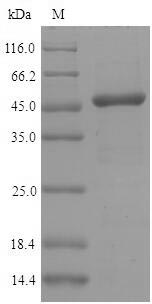CUSABIO transfected the expression vector which inserted the recombinant DNA into the yeast, cultured the cells, and then induced the transcription and translation of the cloned vector. The N-terminal 10xHis tag and C-terminal Myc tag sequence was appended to the gene coding for the yeast of the mouse Irf3 protein to form the recombinant DNA. The recombinant mouse Irf3 was expressed as N-terminal 10xHis-tagged and C-terminal Myc-tagged fusion. The purity of the protein is greater than 90% assayed by SDS-PAGE. It has an apparent molecular weight of approximately 50 kDa.
IFN regulatory factor-3 (IRF-3) is a transcription factor that plays a central role in the host IRF-3 regulates genes in the innate immune response. As a key regulator, IRF-3 influence the IFN-α/β gene expression. IRF-3 activation and, as a consequence, IFN-β mRNA induction are inhibited in wild-type (PR8) influenza virus-infected cells but not in cells infected with an isogenic virus lacking the NS1 gene. Studies found that positiveregulationofinterferon regulatory factor 3activation by Herc5 via ISG15 modification. In addition, ubiquitously expressed IRF-3 is directly activated after virus infection and functions as a key activator of the immediate-early alpha/beta interferon (IFN) genes, as well as the RANTES chemokine gene.






